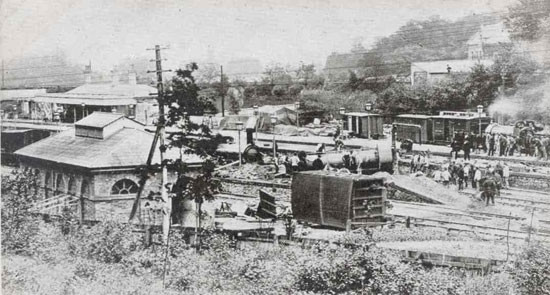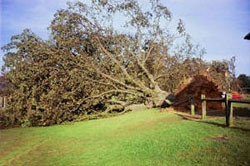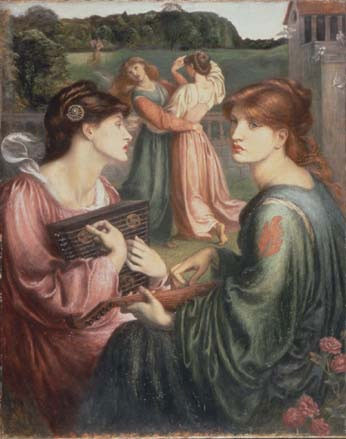The White Hart on Tonbridge Road in Sevenoaks was built high on the Greensand Ridge in the late 16th / early 17th century near to the site of an ancient inn called The Cock.
The legend
A 'hart' is a male deer or stag, but the white hart took on a mythical quality through its association with Herne the Hunter (pronounced 'Ern the 'unter ).
Herne worked for Richard II in Windsor forest, but was fatally injured while defending the king against a cornered white stag. A local wizard restored him to health but, in return, Herne was forced to give up his hunting skills and eventually through frustration and disappointment hanged himself from an oak tree near the castle. Richard II subsequently adopted the White Hart as his crest. Here is a detail from a portrait of Richard 11 painted around 1306, The Wilton Diptych, showing him wearing a brooch with a white hart emblem.
King Richard's White Hart had golden antlers and a golden crown around its neck with a gold chain hanging from the crown. Heraldically, the Hart symbolises peace and harmony, the White denoting purity.
In 1389 Richard passed an Act making it compulsory for pubs and inns to have a sign outside in order to identify them to the official Ale Taster, "otherwise he shall forfeit his ale." Consequently, a great many pubs were named "The White Hart", after Richard II's own heraldic emblem.
Toll Charges
The first turnpike road in Kent from Sevenoaks to Woodsgate (1709) ran past the White Hart. Passing coaches were required to pay a toll to the turnpike trustees. This included those in charge of the four-horse stage coach, which called at the White Hart three times a week on its long journey from the Nag's Head in Southwark to Rye in Sussex.
Knole Park
In 1456 the then Archbishop of Canterbury, Archbishop Bourchier, purchased the 100 acre estate of Knole and built the great house which lies to the eastern side of the town. This was later appropriated by Henry VII and then passed on to Queen Elizabeth I who gave it to her cousin Thomas Sackville.
The Origins of Sevenoaks
The name "Sevenoaks" originated from the Saxon word 'Seouenaca', a name given in about 800 A.D. to a small chapel near seven oaks in Knole Park. Sevenoaks was historically part of the Great Manor of Otford. In 1200, a market was started in the town and due to its economic success, it made Sevenoaks a manor it its own right.
The town's motto is "Floreant Septum Quercus" - " May the Seven Oaks Flourish "
In 1728, seven oak trees were planted on land next to the White Hart, close to the turnpike road, as part of a tradition to perpetuate the name of the town. The trees grew tall and strong but, sadly, were felled in 1955 as they were considered a danger to passing traffic. The novelist Vita Sackville-West and the chairman of Sevenoaks Urban Council, Mrs Eliane Viner jointly planted seven oak saplings in their place, which stand today.
The Great Storm
There is another group of seven oak trees, to the northern side of the Vine Cricket Ground (so named as the land was once used as the vineyard for the Archbishops of Canterbury). The average life of an oak tree is approximately 250 years and so the oaks have been replaced several times. The seven oaks were planted on The Vine in 1902 to commemorate the Coronation of King Edward VII, but during the hurricane of 1987 six of these were blown down and Sevenoaks became "Oneoaks".
Surprisingly, seven new oaks were subsequently planted, which means there are now eight oaks.
Famous Visitors
In 1840, Samuel Palmer, one of England's greatest 19th century landscape artists, stayed at the White Hart Hotel which, he said, cost him 26 shillings a week. Dinner was two shillings per head and breakfast, with eggs or meat, was 1/6d. Whilst there is no evidence of Charles Dickens staying at the White Hart he did make several trips to the area and once rented an apartment in the town of Sevenoaks. It is possible he stood at the bar and enjoyed an ale or two, as his daughter Kate and her husband did whilst staying at The White Hart after Charles' death in 1870.
Whilst on the subject of artists, Dante Gabriel Rossetti painted this wonderful picture in 1850, and used the countryside around Sevenoaks as the background.
Sevenoaks, while being a prosperous and peaceful community, has not been without its share of tragedy. In 1927, a passenger train ran out of control down the bank from the north, and 13 people were killed. Here is a photograph of an earlier train accident which occurred in 1884:
In 1967, The Beatles filmed parts of The Magical Mystery Tour in Sevenoaks, at Knowle Park. Scenes included The Beatles walking down a giant staircase in one of the hangers with 160 dancers at the bottom of it, a tug of war involving 12 children and a number of blindfolded vicars and the famous 'I am The Walrus' scene.
The White Hart In Print
The White Hart features in several publications, including Sevenoaks Essays by Dr Gordon Ward, The Pleasant Town of Sevenoaks by Sir John Dunlop and The Broad Highway, a regency classic written by Jeffrey Farnol. By several accounts, they are not what you might call pot-boilers.






















